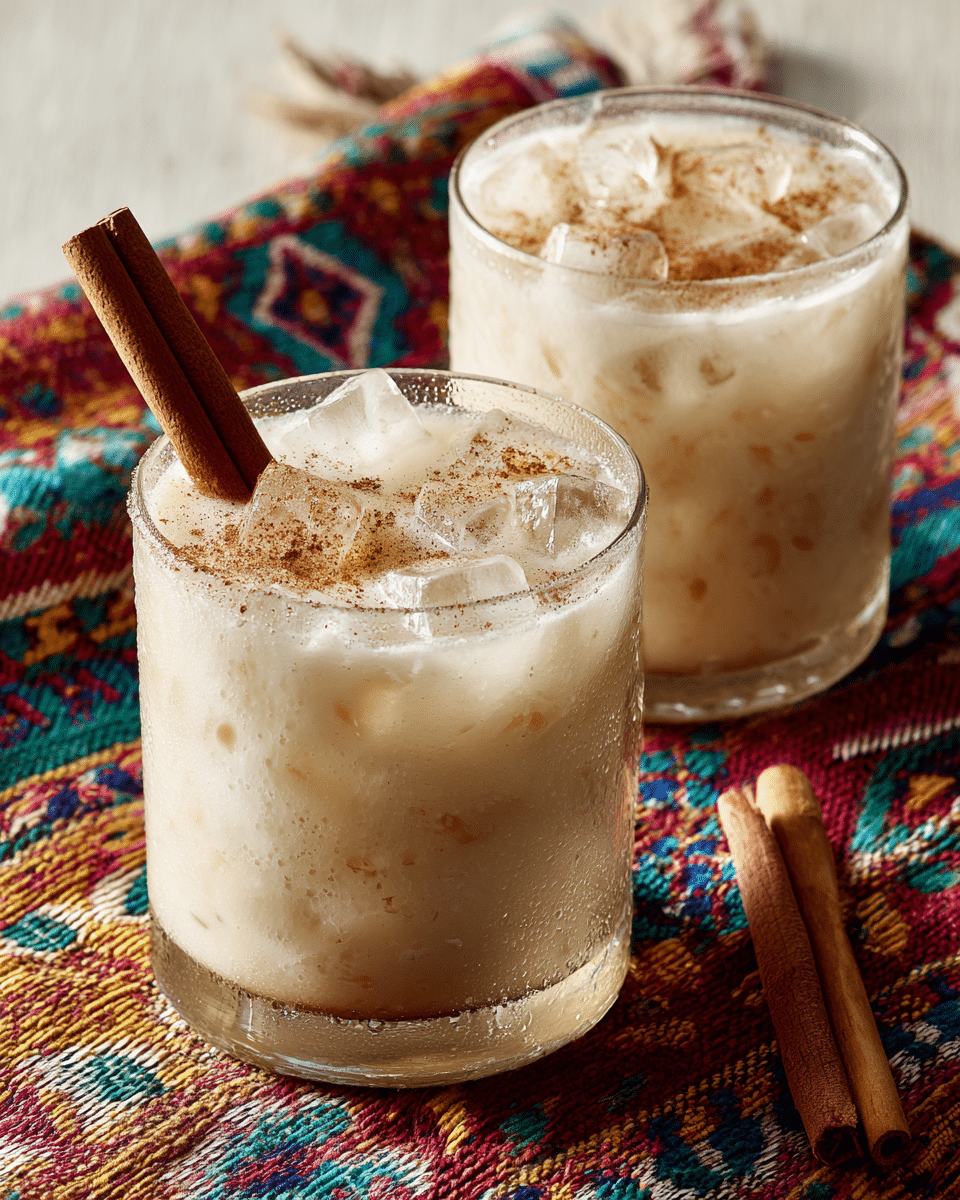Horchata is a beloved traditional beverage originating from Latin America and Spain, known for its sweet, creamy, and nutty flavor. While there are regional variations, Mexican horchata is made primarily with rice, cinnamon, and vanilla, creating a cool and comforting drink perfect for hot days or as a delightful treat. This dairy-free drink is refreshing, satisfying, and easy to prepare at home with just a few pantry staples.
FULL RECIPE
Ingredients
- 1 cup long-grain white rice
- 2 cinnamon sticks
- 4 cups water (for soaking)
- 2 cups water (for blending)
- 1 cup whole milk or dairy-free milk (optional for creaminess)
- 1/2 cup granulated sugar (adjust to taste)
- 1 teaspoon pure vanilla extract
- Ice cubes (for serving)
- Ground cinnamon (for garnish, optional)
Directions
- Rinse the rice thoroughly in a fine mesh sieve until the water runs clear.
- Place the rinsed rice and cinnamon sticks in a large bowl and pour in 4 cups of water. Cover and let soak at room temperature for at least 6 hours or overnight.
- Remove the cinnamon sticks and transfer the rice and soaking water to a high-speed blender. Add an additional 2 cups of water and blend until the rice is finely ground and the mixture is milky, about 2-3 minutes.
- Strain the blended mixture through a fine mesh sieve or cheesecloth into a pitcher to remove any remaining solids.
- Stir in the milk (if using), sugar, and vanilla extract. Mix well until the sugar is completely dissolved. Taste and adjust sweetness as desired.
- Refrigerate the horchata for at least 1 hour to chill.
- Serve over ice and sprinkle with ground cinnamon if desired. Stir before serving as the rice may settle.
Nutrition Facts
- Calories: 130
- Total Fat: 1.5g
- Saturated Fat: 1g
- Cholesterol: 0mg
- Sodium: 10mg
- Total Carbohydrates: 28g
- Dietary Fiber: 0g
- Sugars: 17g
- Protein: 1g
- Calcium: 4% DV
- Iron: 2% DV
Cultural Significance of Horchata
Horchata has deep cultural roots, particularly in Mexico, Central America, and Spain, where it is often enjoyed during warm months as a refreshing drink. Originally derived from a Valencian beverage made with tiger nuts (horchata de chufa), the Latin American versions have evolved, primarily using rice, cinnamon, and vanilla. It’s traditionally served during holidays, family gatherings, and local festivals. Its presence in taquerías and street markets makes it a staple in everyday cuisine and a nostalgic symbol of heritage for many families. Horchata also plays a part in the culinary identity of Mexican-American communities, celebrated for its comforting flavor and adaptability.
Flavor Profile and Texture
The unique flavor of horchata lies in its subtle balance of sweetness, nuttiness, and spice. Rice contributes a mild, creamy base, while cinnamon provides a warm aromatic depth. Vanilla enhances the sweetness, tying everything together into a soothing and flavorful beverage. The drink has a slightly grainy texture, especially if not finely strained, but when well-blended and chilled, it becomes smooth and velvety. The optional addition of milk increases richness and creaminess, making the drink more indulgent. Its light body and refreshing taste make it especially appealing on hot days or after a spicy meal.
Health Benefits of Key Ingredients
Although horchata is often considered a treat, several of its ingredients offer nutritional value. Rice is a source of carbohydrates, providing energy, while cinnamon contains antioxidants and has been studied for its anti-inflammatory properties. Cinnamon may also help regulate blood sugar levels when consumed in moderation. Vanilla extract contains small amounts of minerals and can have mood-enhancing effects due to its pleasant aroma. If using a plant-based milk like almond or oat milk, horchata can be low in cholesterol and saturated fat, making it a heart-friendly alternative to heavier beverages. However, controlling the sugar content is key to making horchata a healthier option.
Popular Variations
Across Latin America, horchata takes on many forms depending on the region. In El Salvador, horchata is made with a mix of ground seeds, including morro, sesame, and pumpkin seeds, yielding a nutty, earthy flavor. In Spain, horchata de chufa is made from ground tiger nuts and has a distinct taste and consistency. Some modern versions incorporate condensed milk or coconut milk for a richer profile. Others experiment with flavorings such as cocoa powder, coffee, or even strawberries. These creative spins highlight horchata’s versatility and how it can be customized to suit different palates, dietary needs, or occasions.
Serving Suggestions
Horchata is best served cold over ice, especially during summer or after a spicy dish to help balance heat. It can be garnished with a light sprinkle of ground cinnamon or a cinnamon stick for presentation. Some serve it in tall glasses with wide straws to enjoy the texture fully. It also pairs beautifully with desserts like churros, tres leches cake, or cinnamon-sugar cookies, enhancing its sweetness. For brunches or casual get-togethers, horchata can be offered alongside pastries, empanadas, or fruit platters. Some even freeze it into popsicles or use it as a base for creamy milkshakes and smoothies.
Food Pairings
Horchata pairs well with bold, spicy dishes thanks to its cooling properties. It complements Mexican classics such as carne asada tacos, enchiladas, tamales, or pozole. Its sweetness contrasts beautifully with salty or savory foods, making it an excellent addition to taco nights or barbecue feasts. For dessert pairings, horchata shines with cinnamon-forward treats or anything with caramel, chocolate, or vanilla. It also works well with breakfast items like cinnamon rolls, French toast, or rice pudding. When used creatively, horchata can even serve as a complementary ingredient in cocktails, adding a sweet, spiced note to adult beverages.
Storage and Shelf Life
Freshly made horchata should be stored in an airtight container in the refrigerator and consumed within 3 to 4 days. Because it is homemade and lacks preservatives, it can spoil quickly if left at room temperature. It’s important to stir or shake the mixture before each serving, as the rice solids may settle at the bottom. If milk is added, the shelf life shortens slightly, and careful refrigeration is essential. Horchata can also be frozen in ice cube trays for later use in smoothies or iced coffee. Always use clean utensils when serving to prevent cross-contamination and maintain freshness.
Tips for a Creamier Horchata
Achieving a rich, creamy texture in horchata depends on your blending and straining technique. Soaking the rice long enough softens it, allowing for smoother blending. Using a high-speed blender ensures that the rice and cinnamon are broken down thoroughly. Straining the mixture twice through a fine mesh sieve or cheesecloth helps eliminate any grainy residue. For extra creaminess, incorporate milk, sweetened condensed milk, or evaporated milk. Plant-based options like almond or oat milk also add body while keeping it dairy-free. Chilling the horchata for several hours before serving enhances both the flavor and mouthfeel.
Making Horchata Vegan or Dairy-Free
Traditional horchata is often dairy-free, but some recipes include milk or condensed milk for richness. To make it entirely vegan, simply omit dairy and use plant-based milk alternatives such as almond, oat, soy, or coconut milk. These choices offer their own flavor nuances while keeping the drink creamy and satisfying. Sweeteners like agave syrup or maple syrup can replace refined sugar if desired. When selecting plant-based ingredients, opt for unsweetened versions to control overall sweetness. This flexibility makes horchata accessible to those with lactose intolerance, dairy allergies, or those following a vegan lifestyle.
Common Mistakes to Avoid
While horchata is simple to prepare, a few common mistakes can affect its flavor and texture. Not soaking the rice long enough can result in a gritty or uneven blend. Using too much cinnamon or vanilla may overpower the delicate balance of flavors. Over-sweetening is another pitfall—start with less sugar and adjust to taste. Skipping the straining step may leave a chalky texture, especially if a lower-powered blender is used. Lastly, not chilling the drink sufficiently can make it taste flat; horchata should always be served cold for maximum enjoyment. Taking care with each step ensures a smooth and delicious outcome.
Conclusion
Horchata is more than just a beverage—it’s a cultural symbol, a nostalgic comfort, and a versatile recipe that bridges tradition and creativity. From its rich historical roots to its modern adaptations, horchata continues to win hearts with its sweet, creamy, and refreshing qualities. Whether served at a summer fiesta, paired with spicy food, or enjoyed as a dairy-free treat, horchata offers both flavor and function.






